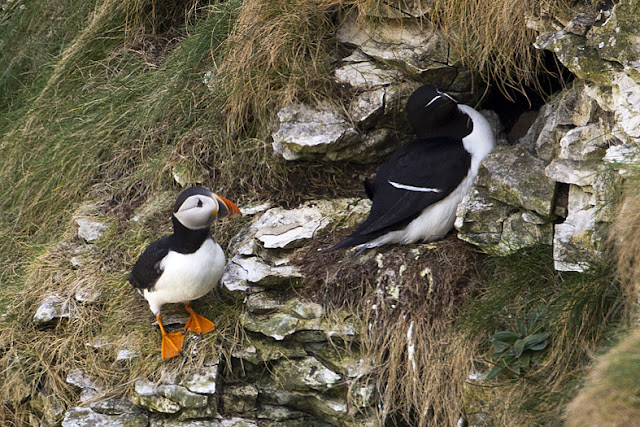What a difference a day can make. I was out on Tuesday around Pagham Harbour and the Chichester Gravel Pits but it was overcast and cold and there was nothing moving and very little singing. A couple of distant Common Terns and two Hobby hawking around Ivy Lake were the best sightings of the day. I managed to conceal myself in the bushes and had the Hobby flying by within fifteen feet of me. Great to see but not much good for photography. After about 30 shots and not having got the birds in frame once I gave up and went home early.
I went out again today. It was cold but the sun was shining and there was a lot more activity. I headed over to the North Wall at Pagham again hoping to see a Turtle Dove I had been looking for the previous day. No luck with that but instead there was a Cuckoo sitting in the tree that I had been staking out.
 |
| Cuckoo |
My being there did not seem to worry him but he was under attack from a male Chaffinch and after a token resistance he soon got fed up and moved on with the Chaffinch in hot pursuit. The Chaffinch came back and posed on the same branch, looking every bit the victor, but somehow it did not make such an interesting picture.
I had a look at Church Norton but, with the tide in, there were few birds about. As it looked like rain I decided to return home via the Arundel Wetland Centre. There is a lot of landscaping taking place on the site so I did not expect to see much in the way of wild birds but at least if it rained there would be plenty of shelter in the hides.
As I walked through the reed bed a Cetti's warbler started up close by and I caught a glimpse of him in the tree.
 |
| Cetti's hiding in the tree |
He disappeared as quickly as he had arrived but at least this time I had seen his face and managed to get a picture, where usually all I see is the back end as they disappear into the bush. Not expecting to see him again I started to move off when he called again this time even closer, and I found him sitting out in the open.
 |
| Cetti's Warbler |
 |
| Out in the Open |
 | |
| and staying for a few pictures |
I managed to get quiet a few pictures before another visitor disturbed him. Most of the pictures have an out of focus branch or reed across his face, so I have some detailed work to do in Photoshop to clean up the best ones, but I am more than happy with what I have got. This bird has been on the top of my hit list for a long time.
For once there seemed to be quiet a lot going on at Arundel. Plenty of chicks but not all of them pretty.
 |
| Looks more like an old man |
 |
| but at least his mother still loves him |
Shelduck seem to be everywhere this year so they must have been one of the more successful breeders last year. It looks as though they are off to another good start.
 |
| Shelduck |
Lots of Hirundines over the scrape but it only seems to be the Swallows that you see perched at this time of year. House Martins will give better picture opportunities when they flock before migrating and I don't think I have ever seen a Sand Martin other than in flight.
 |
| Swallow |
Lots of other birds about including this Common Tern. Not too bad a picture given that it was taken through a plastic window in the hide.
 |
| Common Tern - not looking very happy in the heavy rain |
Only one pair seem to be building a nest. Even if they lay eggs the chances of successful fledging must be limited given all the gulls around them.



























+d.jpg)


















